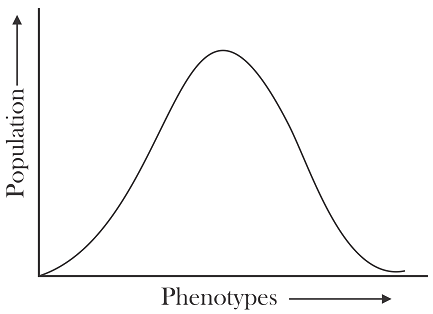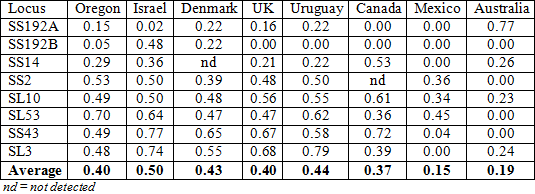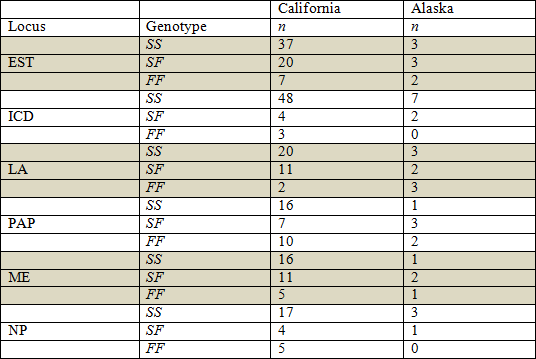Congratulations - you have completed .
You scored %%SCORE%% out of %%TOTAL%%.
Your performance has been rated as %%RATING%%
Your answers are highlighted below.
Question 1 |
Which of the following statements does not describe natural selection:
If a group of organisms relocates to a new environment, or if its current environment changes, the organisms that have a higher fitness in the new environment will leave more offspring and may, over time, give rise to a new species. | |
Humans have modified many species by selectively breeding individual species to develop new species with specific, desired characteristics | |
Individual organisms with certain characteristics are more fit for their environment than organisms without certain characteristics. The organisms with the best suited characteristics for their environment will live to reproduce, and pass those characteristic on to their offspring | |
Natural selection can increase the proportion of favorable traits in a population |
Question 1 Explanation:
The correct answer is (B). Choice (B) explains artificial selection, the selective breeding of domesticated organisms to increase the expression of desired traits.
Question 2 |
Evidence from which of the following does not support evolution:
Homology | |
Direct observation of natural selection | |
Fossil record | |
Analogy |
Question 2 Explanation:
The correct answer is (D). Analogous structures are similarities that are not attributable to common ancestry.
Question 3 |
Although the leaves of a pitcher plant, a Venus flytrap, and a cactus do not appear to be very similar, they are derived from a structure present in a common ancestor. This is an example of:
Homologous structures | |
Vestigial structures | |
Analogous structures | |
Rudimentary structures |
Question 3 Explanation:
The correct answer is (A). Homologous structures have a common ancestry.
Question 4 |
Male peacocks are famous for their colorful, showy tails, whereas female peahens are brown with no fancy tails. This is an example of sexual dimorphism, found in organisms with two different looks within the species. What mode of selection produces species exhibiting sexual dimorphism?
Stabilizing selection | |
Directional selection | |
Sexual Selection | |
Artificial selection |
Question 4 Explanation:
The correct answer is (C). Sexual selection can lead to the evolution of characteristics, both phenotypic and behavioral, that have an adverse impact on survival but promote fitness.
Question 5 |
Sickle Cell Disease is caused by having two alleles for Hemoglobin S. The Hemoglobin S allele results red blood cells that have a “sickle” shape. Individuals who have one Hemoglobin S allele and one Hemoglobin B allele are said to be “carriers”. Although they have the sickle cell trait, they do not have sickle cell disease. Carriers are resistant to malaria. The Hemoglobin S allele is found most frequently in individuals who have ancestry tracing to the parts of Africa where malaria was more common.
This type of evolutionary fitness is referred to as:
Diploidy | |
Heterozygote advantage | |
Frequency dependent selection | |
Neutral variation |
Question 5 Explanation:
The correct answer is (B). Heterozygote advantage is exhibited in individuals who are heterozygous for a particular trait, and gives the carrier of the trait greater fitness.
Question 6 |
Northern elephant seals were hunted by humans in the 1890s, reducing their population size to 20 individuals. Even though their population is now over 30,000, the seals still have reduced genetic variation. What’s the best explanation of this phenomenon?
Bottleneck effect | |
Founder effect | |
Heterozygote advantage | |
Relative fitness |
Question 6 Explanation:
The correct answer is (A). A severe drop in population size can cause a bottleneck effect. In this case, certain alleles were overrepresented in the population of survivors, and other alleles were underrepresented.
Question 7 |
Certain cavefish and salamanders have non-functional eyes, which are remnants of the functional eyes of their ancestors. Such examples of “leftover” structures are referred to as:
Homologous structures | |
Analogous structures | |
Vestigial structures | |
Genetic drift |
Question 7 Explanation:
The correct answer is (C). Vestigial structures are of little, if any, importance to the fitness of the organism. They are historical remnants of structures that promoted fitness in their ancestors.
Question 8 |
White-tailed deer vary in color from reddish brown in the summer to grayish brown in the winter. However, one percent of the deer population exhibit a recessive genetic trait found in about one percent of all white-tailed deer called leucism. Leucistic white-tailed deer lack pigment over all or part of their bodies. They can have varying levels of white, from having white splotches, to being half brown and half white, to appearing nearly all white. Since a leucistic deer is not very well camouflaged, their chance of survival is very low. The color range of white-tailed deer can be graphed with the following results:


Which of the following statements best indentifies the type of selection resulting in the typical reddish brown to grayish brown coat of white-tailed deer?
Directional selection | |
Disruptive selection | |
Stabilizing selection | |
Artificial selection |
Question 8 Explanation:
The correct answer is (C). Stabilizing selection removes extreme variants (white coat) from the population and preserves the intermediate phenotypes (reddish brown to grayish brown).
Question 9 |
Questions 9–11
Mycosphaerella graminicola causes a disease known as speckled leaf spot on wheat. This disease has the potential to cause significant grain loss if the environmental conditions are favorable for their spread. Scientists determined the genetic structure of this pathogen in various geographic regions world-wide and found that all populations collected from different geographic locations had similar frequencies of common alleles except the populations collected from Australia and Mexico. Below are the results:


The Mexican population had significantly lower gene diversity, few alleles at each locus, and the gene frequencies were significantly different from populations at other locations. The Mexican population was sampled from a breeding nursery used to screen for resistance to this pathogen. The nursery is located far away from the wheat population area and has a limited potential for influx of natural inoculation, and was inoculated with a limited number of strains of the pathogen. This is an excellent example of:
Founder Effect | |
Bottleneck Effect | |
Natural Selection | |
Balancing Selection |
Question 9 Explanation:
The correct answer is (A). Founder effect occurs when a few individuals have been isolated from a larger population, and thus a smaller group of individuals establishes a new population whose gene pool differs from the source population. In this case, the Mexican population of the speckled leaf spot was isolated from the general population. This presents a clear example of genetic drift due to a small founding population.
Question 10 |
Questions 9–11
Mycosphaerella graminicola causes a disease known as speckled leaf spot on wheat. This disease has the potential to cause significant grain loss if the environmental conditions are favorable for their spread. Scientists determined the genetic structure of this pathogen in various geographic regions world-wide and found that all populations collected from different geographic locations had similar frequencies of common alleles except the populations collected from Australia and Mexico. Below are the results:


In Australia, only a relatively small number of individuals arrived on this continent with the introduction of modern agriculture, and therefore
It is likely that a sudden change in the environment caused a bottleneck effect | |
Mutations resulting from natural selection have created new pathogens in the original strain | |
The low gene diversity is consistent with the founder effect | |
The transfer of alleles into a new population |
Question 10 Explanation:
The correct answer is (C). With the introduction of modern agriculture to Australia, a few individuals of the speckled leaf spot were isolated from the larger population, and thus less genetic diversity was present.
Question 11 |
Questions 9–11
Mycosphaerella graminicola causes a disease known as speckled leaf spot on wheat. This disease has the potential to cause significant grain loss if the environmental conditions are favorable for their spread. Scientists determined the genetic structure of this pathogen in various geographic regions world-wide and found that all populations collected from different geographic locations had similar frequencies of common alleles except the populations collected from Australia and Mexico. Below are the results:


The geographic area with the highest level of gene diversity speckled leaf spot is likely to be the center of origin. Based on this data, that area would be
Europe | |
Asia | |
Middle East | |
North America |
Question 11 Explanation:
The correct answer is (C). Israel has the highest average gene diversity, and is likely to be the center of origin.
Question 12 |
A study published by a team led by the U.S. Geological Survey (USGS) revealed the movement of polar bears toward areas with more persistent sea ice. The researchers defined four general polar bear population clusters: Eastern Polar Basin, Western Polar Basin, Canadian Archipelago, and Southern Canada. By looking at the genes of the polar bears, they found that the polar bears have recently begun to move in a northward direction, from Southern Canada and Eastern Polar Basin into the Canadian Archipelago. The team of researchers hypothesized that the Canadian Archipelago will be a future refuge for polar bears if climate change continues to trend toward a warmer climate.
This movement of polar bear populations provides a prime example of
Gene Flow | |
Neutral Variation | |
Directional Selection | |
Founder Effect |
Question 12 Explanation:
The correct answer is (A). Gene flow is the movement of allele frequencies into or out of a population due to the movement of fertile individuals and their gametes.
Question 13 |
Questions 13–14
Lidicker and McCollum (1997) examined genetic variation in two populations of sea otters in the eastern Pacific. Before fur hunting led to their near extinction, sea otters were distributed throughout the region. Along the central California coast, it is estimated that only one population of 50 or fewer individuals survived. Since this population was protected in 1911, it has grown to over 1500 otters. The population may have lost considerable genetic variation due to the extreme reduction in population size. A population from Alaska experienced a similar bottleneck around that time, but it was not as severe.
One way to look at genetic diversity is to study the allele and genotype frequencies of allozymes. Allozymes are enzymes that show different rates of movement in gel electrophoresis due to the presence of different alleles at a single locus, whereas F is the fast-moving allele, and S is the slow-moving allele. The table below shows the number of individuals with a given genotype for six variable (polymorphic) two-allele loci:
One way to look at genetic diversity is to study the allele and genotype frequencies of allozymes. Allozymes are enzymes that show different rates of movement in gel electrophoresis due to the presence of different alleles at a single locus, whereas F is the fast-moving allele, and S is the slow-moving allele. The table below shows the number of individuals with a given genotype for six variable (polymorphic) two-allele loci:

We can use these data to calculate the allelic frequencies for a given locus, such as the ME locus in the California population. How many S alleles are there in the population?
43 | |
21 | |
32 | |
27 |
Question 13 Explanation:
The correct answer is (A). Each individual with the genotype SS has two copies of the S allele;
therefore the 16 individual with this genotype have a count of 32 S alleles. The
heterozygote individuals (SF) have one of each allele, so there are 11 S alleles and 11 F
alleles among them, bringing the total of S alleles to 43 (16 + 16 + 11).
Question 14 |
Questions 13–14
Lidicker and McCollum (1997) examined genetic variation in two populations of sea otters in the eastern Pacific. Before fur hunting led to their near extinction, sea otters were distributed throughout the region. Along the central California coast, it is estimated that only one population of 50 or fewer individuals survived. Since this population was protected in 1911, it has grown to over 1500 otters. The population may have lost considerable genetic variation due to the extreme reduction in population size. A population from Alaska experienced a similar bottleneck around that time, but it was not as severe.
One way to look at genetic diversity is to study the allele and genotype frequencies of allozymes. Allozymes are enzymes that show different rates of movement in gel electrophoresis due to the presence of different alleles at a single locus, whereas F is the fast-moving allele, and S is the slow-moving allele. The table below shows the number of individuals with a given genotype for six variable (polymorphic) two-allele loci:
One way to look at genetic diversity is to study the allele and genotype frequencies of allozymes. Allozymes are enzymes that show different rates of movement in gel electrophoresis due to the presence of different alleles at a single locus, whereas F is the fast-moving allele, and S is the slow-moving allele. The table below shows the number of individuals with a given genotype for six variable (polymorphic) two-allele loci:

The number of S alleles in the California population at the EST locus is 94, and the number of F alleles is 34. If this population is in Hardy-Weinberg equilibrium, what would be the expected genotype frequencies for SF for the EST locus in the California population?
0.539 | |
0.390 | |
0.071 | |
0.266 |
Question 14 Explanation:
The correct answer is (B). First, it is necessary to calculate the allelic frequencies by dividing the
number of S or F alleles by the total number of alleles: 94/128 = 0.734 = p = frequency of the S allele, and 34/128 = 0.266 = q = frequency of the F allele. If the population is in
Hardy-Weinburg equilibrium, we would expect the genotype frequency for SF = 2pq =
2(0.734)(0.266) = 0.390.
Question 15 |
Which of the following is not a correct condition for Hardy-Weinburg equilibrium to be met:
No mutations | |
No gene flow | |
No natural selection | |
Selective mating |
Question 15 Explanation:
The correct answer is (D). If individuals mate preferentially within a population, random mixing of gametes will not occur and the genotype frequencies change.
Once you are finished, click the button below. Any items you have not completed will be marked incorrect.
There are 15 questions to complete.
|
List |
Next Practice Test:
Common Ancestry >>
AP Biology Main Menu >>
